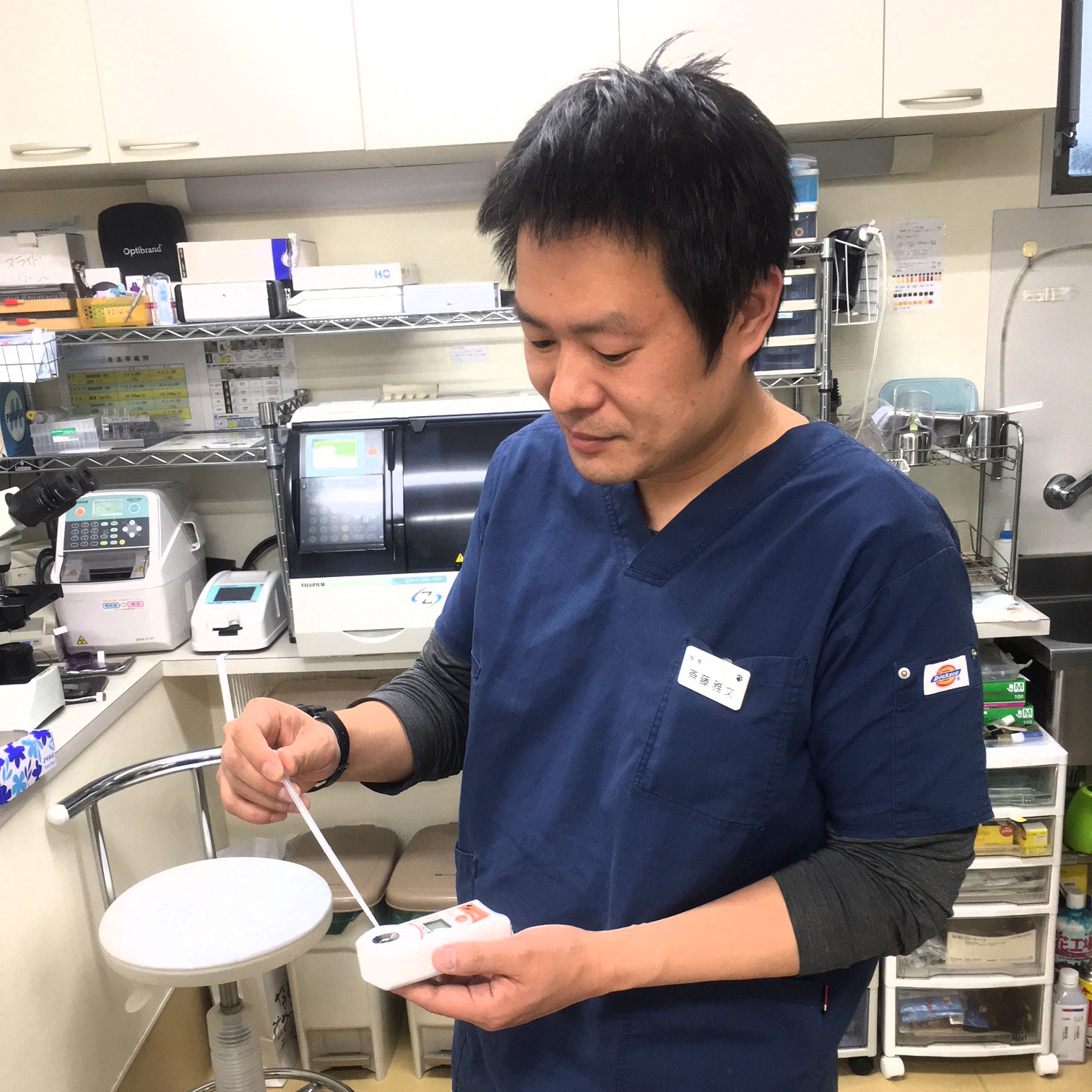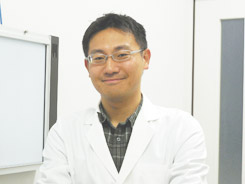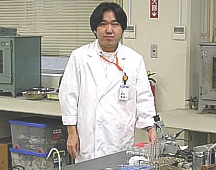

The Crews Animal Hospital is a veterinary clinic with integrated pet salon and pet hotel located in Chofu City, Tokyo, Japan. In the morning, the clinic is cleaned, boarded pets are walked, meals are prepared, and veterinary care and medications are provided. The outpatient visits are available all morning and afternoon. Lunch time is filled with scheduled surgeries and examinations and after hours are used to take care of the boarded pets, every day is a busy day. Nonetheless, seeing pets recover and pet owners be pleased with the service is very motivating and rewarding for them.
Dr. Saito,the director of the Crews Animal Hospital said that animals cannot speak for themselves to tell you what is wrong with them. In order to notice even minor changes in an animal’s behavior or condition, it is important to examine each animal with the utmost care.
No mistakes are allowed when diagnosing. At the Crews Animal Hospital, a urine specific gravity meter PAL-DOG&CAT is used which can measure accurate value of urine specific gravity for evaluation of kidney function.
“We have been using an analogue urine specific gravity meter for human use and in 2014 we purchased PAL-DOG&CAT. Due to the fact that the analogue unit was made for humans, the results of the urine specific gravity must be convert to that of dogs and cats. By switching to PAL-DOG&CAT conversion is no longer needed. The PAL-DOG&CAT can measure high range values and is easy to measure. ”
At Crews Animal Hospital, PAL-DOG&CAT urine specific gravity meter is used every day, even more so than ever.

Nippon Veterinary and Life Science University
We spoke with Dr. Yuichi Miyagawa(※).
At veterinary hospitals, urine specific gravity is always measured as a part of urine examination. For example, chronic kidney disease is a common problem and is one of the leading causes of death in felines.
This disease often has almost no obvious symptoms and is frequently unrecognized, leading to delayed diagnosis. Accelerated progression of this disease is associated with weight loss, loss of appetite and excess water intake and urination.
Chronic kidney disease impairs function to properly concentrate urine, consequently decreasing urine specific gravity. For this reason, measuring urine specific gravity can contribute to early detection.
Measuring urine specific gravity is important in diagnosing kidney disease especially because specific gravity of canine and feline urine decreases remarkably even more so than that of humans.
The normal urine specific gravity of a dog is commonly around 1.025 or more and for a cat, 1.035 or more.
Unlike human, a catheter is used to collect urine samples because animal urine is not as freely accessible; however, collection during urination will have the least amount of stress for the animals.
Recently, some pet owners purchases their own urine specific gravity meter. The best way to collect urine at home is to use a cat litter like the ones sold by Kao.
Urine specific gravity is measured by a urine specific gravity meter. For easier and quicker testing, we use ATAGO’s urine specific gravity meter (PAL-DOG&CAT). Just drop a few drops of collected urine, press the start button, and the result will display after 3 seconds.
In the past, analog urine specific gravity meter was used, however, we use the digital model specifically for pets more often now.
The digital display is very easy to read and convenient to use. The one being used is more than 10 years old and has never once broke. It is used with confidence in our clinical practices.
We thank you for your continuing parsonage.

Toho University was established in 1925 as a University of Science. ATAGO staff visited the Polymer Chemistry Lab that is part of Department of Chemistry. The lab is part of Narashino campus, located in Narashino, Chiba.
In this lab, under supervision of Professor Masatoshi Hasegawa and lecturer Junichi Ishii, they do extensive research on polymeric materials such as polyimide or polybenzoxazoles. These resins have the highest level of heat resistance for organic compounds.
We interviewed Mr. Ishii.
QWhat sort of experiments do you conduct?
AIn this polymer lab, we do extensive research on polymers' properties and applications. For example, we are developing next-generation insulating materials using polyimide.
QPlease tell us more about your experiments on polyimide.
APolyimide is one of the materials for flexible print circuit boards, used commonly in cell phones, PCs, and digital cameras. Two major characteristic of polyimide are:
-High temperature resistance… Can resist more than 260℃/500°F (can withstand lead-free soldering)
-Dimensional stability under high heat… Since Polyimide is often combined with inorganic materials (copper, ITO circuits, silicon wafers, etc) dimensional stability similar to metals is necessary to prevent problems such as warping or cracking.
We strive to optimize such qualities of Polyimide and, ultimately, develop a new resin that satisfies multiple qualities (such as thermoplasticity, transparency) and functions (such as photosensitivity, heat conductivity).
An important part of our experiment is to measure refractive index of polyimide film. Dimensional stability of polyimide is dependent on orientation of in-plane polymer chain. Birefringence is unique to each degree of orientation, so for each polyimide prototypes we use Abbe refractometers to check its refractive index.
QHow do you create these prototypes?
AMonomers are combined in a solvent to create polymer chains. This solution is spread out on a sheet of glass to dry, so that solvent will evaporate and only polymers will remain as film. Thermal treatment is given as necessary to complete the polymer film prototype.
QWhat is the physical chemistry lab like?
AIt's an interactive lab course that our third year students participate in. About 60 students conduct eight experiments. Each experiment takes about four hours each day, lasting two days. One of the experiments is to measure refractive index.
QPlease describe your refractive index experiment.
AWe have five Abbe refractometers, three of which were renewed recently. Each experiment is conducted by a pair of students.
There are three main parts to this experiment.
1. Measuring refractive index of different alcohols
Students take measurements of ten alcohols that differ in molecular mass. Alcohols used in this experiment are monovalent (contains one hydroxyl group). They then examine the relationship of refractive index and molecular weight. It becomes evident that refractive index is relative to inverse value of molecular weight, allowing the students to find its empirical composition. From this empirical composition the refractive index of an unknown sample is calculated and, with comparison to provided data, hypothesis is drawn.
2. Measuring refractive index of compound liquids – alcohol-water mixture, heptane-cyclohexane mixture
Students take various measurements for RI at different degree of mixtures (0~100mol% ) of alcohol-water and heptane-cyclohexane. Using these data students can infer if RI and compositional ratio are related to additive property. There's a large difference in behavior between the two compound liquids. We have our students study how this may be so.
*Additive property … When the volume of a compound is the sum of volumes of component atoms. There is no additive property for volume of water and ethanol. Some reasons to this are size difference in their molecules and its strong heterodimeric interaction.
3. Measuring refractive index of calcium fluoride (solid)
In this experiment students measure refractive index of solid. First, calcium fluoride is placed in a test tube. Then, toluene and heptane are mixed into the test tube. Once calcium fluoride becomes invisible, liquid and solid have the same refractive index. By measuring the refractive index of liquid at this point, RI of solid can also be known.
*We refer to this as the Becke line test.
Your curriculum is a great learning experience for students. It's very interactive, but also insightful, as they get to actually measure RI and draw hypothesis from their observations.
All experiments are simple and tangible. At the same time, it allows for creative assessments, so I get a wide array of reports. Some reports are very insightful, while others are highly observing. All students are very hardworking and eager to learn.
Dr. Ishii, thank you for your help and thorough explanations. We look forward to your continued support. We wish the very best for continued success of Dr. Hasegawa and Dr. Ishii.
Visit Toho University Polymerchemistry Lab's website at:
https://www.toho-u.ac.jp/sci/chem/lab/polymerchem_lab/index.html
Dr. Saito, thank you for taking the time to speak with us.
We thank you for your continuing patronage.
Crews Animal Hospital's Website
http://crews-doubutsu-byouin.jp/